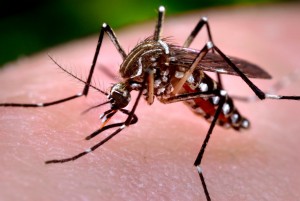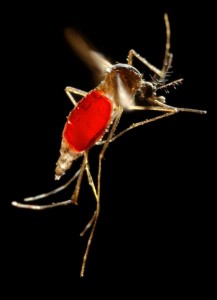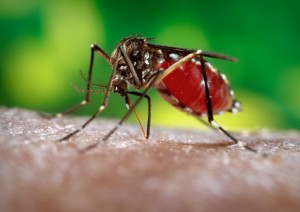Disrupting an olfactory neuron to prevent mosquito bites to humans

It is well known just how efficient mosquitoes are at deciphering the complex chemical environment around them to find hosts, food and oviposition sites. However, determining the precise mechanisms that underlie these capabilities has proven elusive. Today, our understanding of the mosquito olfactory system has improved substantially, and this may lead to the design of novel control strategies to significantly improve global health in the near future.
Major mosquito olfactory organs, antennae and maxillary palps, are covered with thousands of hair-like olfactory structures called sensilla. Each sensilla contains a fixed number of olfactory receptor neurons (ORNs) which themselves express different combinations of olfactory proteins that are directly responsible for the reception of specific ligands (volatile odors) from the chemical landscape around them. This sophisticated sensory system is a fundamental property of mosquito olfaction as it enables critical behaviors, including the localization of nectar sources, appropriate host to feed upon and suitable site to lay eggs. In this context, the capacity to manipulate relevant ORNs and proteins involved in host-seeking and host discrimination would create exciting opportunities to tackle the transmission of mosquito-borne diseases to humans.

In a recent high-profile publication, researchers at the University of California Riverside conducted a detailed analysis of the CO2-sensitive ORN, cpA. This neuron has been shown previously to mediate robust attraction to CO2, a major host-derived chemical cue for host-seeking female mosquitoes. The authors demonstrated that cpAis involved in the detection and attraction to human skin odor components, in addition to CO2. Building upon this finding, the authors used an in silico chemical informatics screen to identify novel chemicals that are structurally similar to newly identified cpA ligands. From the screening of approximately half a million chemicals, just over a hundred candidates were selected for further testing. In order to test the validity of the screen, electrophysiological methods were used to determine whether candidate ligands could directly affect the excitability of cpA. Indeed, most candidate chemicals were successful at either exciting or inhibiting the activity of cpA. More importantly, a subset of the novel ligands elicited strong behavioral effects in host-seeking females by either masking the detection of CO2 and skin odor (antagonists capable to abolish attraction to humans) or attracting female mosquitoes in the absence of CO2 (agonists capable to lure mosquitoes into traps).
This study, via its novel and revolutionary “computational reverse chemical ecology” approach, is clearly important for providing potential replacements for widely employed mosquito attractant (CO2) and repellent (N,N-Diethyl-meta-toluamide; or DEET). The development of better, safer and more affordable control molecules is very promising and could pave the way towards a new era of olfactory-based insect control strategies. The question remains, however, as to whether these novel molecules can be applied efficiently outside of the laboratory to control mosquito populations. Such critical validation will depend on field experiments conducted under more natural conditions. As such, only time will tell.
Considering the vast diversity of ORNs and olfactory proteins that have yet to be characterized, I am confident that more valuable targets will be identified in mosquitoes

and other insect vectors, as well as in pest species. The ongoing development of novel research tools, especially RNA sequencing and transgenic techniques (see this reference and this one for more information), should be instrumental for the identification and characterization of proteins involved in robust olfactory behaviors and thus amenable for designing efficient species-specific and environmentally-friendly control strategies.

[…] identical approach was used to knock-out a gustatory receptor (Gr) subunit, Gr3, expressed in the CO2-sensitive ORN called cpA. Gr3 mutants, rendered insensitive to CO2, lacked the typical flight activation pattern, confirming […]